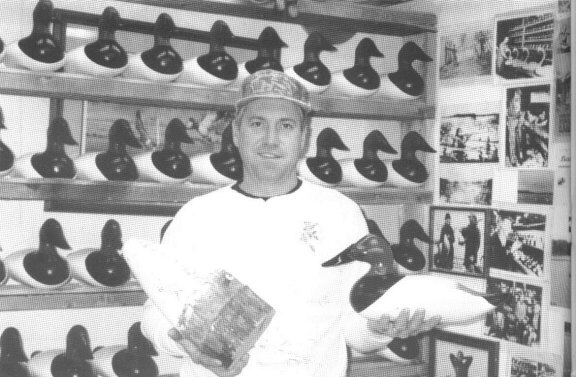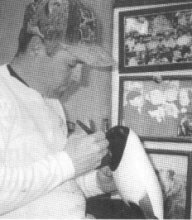A Helping hand for the Rebecca T. Ruarkby
Jennifer Jones
Printed
in the Spring 2000 issue of "The Canvasback" , Havre de Grace Decoy
Museum's Magazine!
There
is a remarkable spirit of community that unites those who have built their lives
around the Chesapeake Bay. Springing from a respect for a collective heritage
and an understanding of the uncertainty of a livlihood dependent on nature, this
sense of kinship ensures that when one waterman encounters a
challenge, others will be there to lend a helping hand. Such is the case with
the recent partnership between decoy carver Charles Jobes of Havre de Grace and
skipjack captain Wade H. Murhy, Jr. of Tilghman Island.A
third-generation skipjack waterman, Captain Murphy had sailed the Rebecca
T. Ruark for fifteen years when it sunk in a storm last November (1999).
Built in 1886 on Maryland's Taylor's Island as the last of the round bottomed
oyster boats, the Rebecca T. Ruark was the oldest working skipjack
on the Chesapeake Bay and the winner of numerous sailing competitions. Captain
Murphy chartered the vessel for family excursions, special occasions and
overnight trips, all of which featured authentic oyster-dredging demonstrations.
Sailing the skipjack and sharing his heritage with the public was Captain
Murphy's life.But on the afternoon of November 2, all of
that was lost when the Rebecca T. Ruark foundered in the Choptank
River after 40 mph winds and 55 mph gusts ripped her and broke her boom. The
Captain and his crew were rescued, but the skipjack could not be. The following
morning t 2:00 a.m., a distraught Captain Murphy returned to the river and
searched for the vessel, which he finally located when he spotted the tip of its
mast jutting out of the water. Several early attempts to raise the ship failed.
Ultimately, the State of Maryland recognized the historical significance of the
skipjack and provided funding for Martin G. Imbach, Inc. to raise the vessel.
Perhaps the future of the Rebecca T. Ruark could be salvaged, but
Captain Wade Murphy would have to find some way to cover the costs of
restoration, which were estimated at $50,000 to $60,000.
|
Charlie Jobes proudly displays
the tip of the Rebecca's mast , which he will keep, and one of the
canvasbacks carved from the mast. |
|

|
It
was to that end that Captain Murphy approached carver Charles Jobes with a
proposal at the Easton Waterfowl Festival, where Jobes was exhibiting his
decoys. Trained in the art of decoy making by his father, Captain Harry Jobes,
Charles has been carving since he was seven years old and has become on of Havre
de Grace's most respected artists. In fact, the entire Jobes family is devoted
to the art and to the Chesapeake Bay. Although Jobes was only casually
acquainted with Captain Murphy, he is, like Murphy, a waterman who helps support
his family by fishing and crabbing. When Captain Murphy asked him to make decoys
from the mast of the Rebecca T. Ruark and donate the proceeds to
the restoration of the skipjack, Jobes responded enthusiastically.
| Charles Jobes at work on one of the
final canvasbacks carved from the mast of the Rebecca T. Ruark. |

|
In
all, Charles Jobes carved eighty-four canvasback drakes from the mast's wood.
The task proved a bit of a challenge due to the fact that the mast was made of
Oregon pine, a heavy wood with a hard grain that makes carving more difficult
than the white pine that Charles favors. Still, it took only two weeks for Jobes
to carve and paint all eighty-four birds. Each decoy was signed by both Charles
Jobes and Captain Wade Murphy, numbered, and accompanied by a certificate of
authenticity. Jobes himself asked only $55 per decoy in compensation. His real
motivation in carving the decoys was his desire to help preserve a piece of the
heritage that is so central to his life and that of his family.The
wider community also lent their support to the project. Before Jobes had even
finished making the decoys, the first twenty birds sold for a price of $500. The
remaining canvasbacks, priced at $1000 each, proved equally popular, selling out
within an incredible four to five days in late February. Not only were buyers
eager to own one of these limited-edition keepsakes, they were anxious to
support Captain Murphy's restoration effort. Now, with the money raised from the
sale of the decoys, work toward the restoration of the Rebecca T. Ruark
can proceed. Sadly, the skipjack will not be ready for this year's oyster
season, but, barring complications, the Rebecca will be sailing the Bay by next
spring. As is so often the case when those who love and depend upon the
Chesapeake Bay come together, there is hope for the future.*Editors
Note*
I do not have the
permission of the publisher to have this article here, I am writing
re-printing it here giving the credit to the author and the publication from
which I copied it from. Thanks
|

 WEBBED FEET
WEBBED FEET

 WEBBED FEET
WEBBED FEET